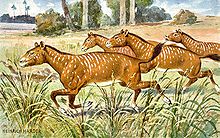Mesohippus
| Mesohippus | |
|---|---|

| |
| Mesohippus barbouri | |
| Scientific classification | |
| Domain: | Eukaryota |
| Kingdom: | Animalia |
| Phylum: | Chordata |
| Class: | Mammalia |
| Order: | Perissodactyla |
| Family: | Equidae |
| Subfamily: | †Anchitheriinae |
| Genus: | †Mesohippus Marsh, 1875 |
| Species | |
|
See text | |
Mesohippus (
Description

Mesohippus had longer legs than its predecessor

Unlike earlier horses, its teeth were low crowned and contained a single gap behind the front teeth, where the bit now rests in the modern horse. In addition, it had another grinding tooth, making a total of six. Mesohippus was a browser that fed on tender twigs and fruit.[5] The cerebral hemisphere, or cranial cavity, was notably larger than that of its predecessors; its brain was similar to that of modern horses.
Species
- M. bairdi
- M. barbouri
- M. braquistylus
- M. equiceps
- M. hypostylus
- M. intermedius
- M. latidens
- M. longiceps
- M. metulophus
- M. montanensis
- M. obliquidens
- M. proteulophus
- M. westoni
See also
References
- ^ "Mesohippus". Florida Museum. 2018-02-16. Retrieved 2022-10-03.
- ^ "Mesohippus". International Museum of the Horse. Retrieved 2022-10-03.
- ISBN 978-0-8137-2435-5.
- ^ MacFadden, B. J.. 1992. Fossil Horses: Systematics, Paleobiology, and Evolution of the Family Equidae. Cambridge University Press, Cambridge.
- ISBN 1-84028-152-9.
